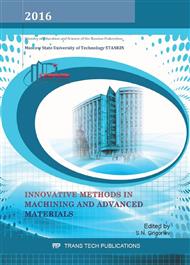[1]
S. Grigoriev, A. Metel, Plasma- and beam-assisted deposition methods, in: Nanostructured thin films and nanodispersion strengthened coatings. Kluwer Academic Publishers, Boston, Dordrecht, London, 2004, p.147–154.
DOI: 10.1007/1-4020-2222-0_14
Google Scholar
[2]
J. Musil, Low-pressure magnetron sputtering, Vacuum. 50 (1998) 363-372.
DOI: 10.1016/s0042-207x(98)00068-2
Google Scholar
[3]
J. Amano, R. Lawson, Thin film deposition using low energy ion beams (3) Mg+ ion-beam deposition and analysis of deposits, J. Vac. Sci. Technol. 14 (1977) 695-698.
DOI: 10.1116/1.569185
Google Scholar
[4]
C. Ruset, E. Grigore, The influence of ion implantation on the properties of titanium nitride layer deposited by magnetron sputtering, Surf. Coat. Technol. 156 (2002) 159-161.
DOI: 10.1016/s0257-8972(02)00121-4
Google Scholar
[5]
C. Ruset, E. Grigore, G.A. Collins, K.T. Short, F. Rossi, N. Gibson, H. Dong, T. Bell, Characteristics of the Ti2N layer produced by an ion assisted deposition method, Surf. Coat. Technol. 174/175 (2003) 698-703.
DOI: 10.1016/s0257-8972(03)00411-0
Google Scholar
[6]
E. Grigore, C. Ruset, K.T. Short, D. Hoeft, H. Dong, X.Y. Li, T. Bell, In situ investigation of the internal stress within the nc-Ti2N/nc-TiN nanocomposite coatings produced by a combined magnetron sputtering and ion implantation method, Surf. Coat. Technol. 200 (2005).
DOI: 10.1016/j.surfcoat.2005.02.118
Google Scholar
[7]
H.R. Kaufman, Broad-beam ion sources, Rev. Sci. Instrum. 61 (1990) 230-235.
Google Scholar
[8]
N.V. Gavrilov, G.A. Mesyats, G.V. Radkovskii, V.V. Bersenev, Development of technological sources of gas ions on the basis of hollow-cathode glow discharges, Surf. Coat. Technol. 96 (1997) 81-88.
DOI: 10.1016/s0257-8972(97)00096-0
Google Scholar
[9]
A.S. Metel, Beams of fast neutral atoms and molecules in low-pressure gas-discharge plasma, Plasma Physics Reports. 38 (2012) 254-262.
DOI: 10.1134/s1063780x12020080
Google Scholar
[10]
A.S. Metel, S.N. Grigoriev, Yu.A. Melnik, V.P. Bolbukov, Broad beam sources of fast molecules with segmented cold cathodes and emissive grids, Instruments and Experimental Techniques. 55 (2012) 122-130.
DOI: 10.1134/s0020441211060170
Google Scholar
[11]
A.S. Metel, Yu.A. Melnik, V.V. Panin, Non-self-sustained glow discharge with electrostatic confinement of electrons sustained by a fast neutral molecule beam, Plasma Physics Reports. 37 (2011) 357-365.
DOI: 10.1134/s1063780x11040088
Google Scholar
[12]
A.F. Cakir, A. Metel, M. Urgen, S. Grigoriev, Arc-PVD Coating of Metallic and Dielectric Substrates Using Neutral Molecular Beam Source Pretreatment, Galvanotechnik. 91 (2000) 768-776.
Google Scholar
[13]
S.N. Grigoriev, Yu. A. Melnik, A.S. Metel, V.V. Panin, and V.V. Prudnikov, A compact vapor source of conductive target material sputtered by 3-keV ions at 0. 05-Pa pressure, Instruments and Experimental Techniques. 52 (2009) 731-737.
DOI: 10.1134/s0020441209050170
Google Scholar
[14]
A. Metel, V. Bolbukov, M. Volosova, S. Grigoriev, Yu. Melnik, Source of metal atoms and fast gas molecules for coating deposition on complex shaped dielectric products, Surf. Coat. Technol. 225 (2013) 34-39.
DOI: 10.1016/j.surfcoat.2013.03.013
Google Scholar
[15]
A.S. Metel, Characteristics of the detection of a quasi-stationary state of the heavy-current glow discharge with a hollow-space cathode at low gas pressure, Sov. Phys. -Tech. Phys. 31 (1986) 1395-1405.
Google Scholar
[16]
M. Kaminsky, Atomic and Ionic Impact Phenomena on Metal Surfaces, Springer, Verlag Berlin Heidelberg, (1965).
Google Scholar
[17]
M.B. Guseva, V.G. Babaev, V.V. Khvostov, N.F. Savchenko Controlled Formation Process and Structure of thin Films. Ion-Assisted Processes, Nanotekhnol.: Razrab. Primen. - XXI Vek. 1 (2010) 15-28[in Russian].
Google Scholar
[18]
A.S. Metel, Yu.A. Melnik, V.P. Bolbukov, A source of pulsed beams of high-energy gas molecules, Vestnik MSTU STANKIN, 35 (2015) 74-77.
Google Scholar
[19]
A.V. Phelps, Cross sections and swarm coefficients for nitrogen ions and neutrals in N2 and argon ions and neutrals in Ar for energies from 0. 1 eV to 10 keV, J. Phys. Chem. Ref. Data. 20 (1991) 557-573.
DOI: 10.1063/1.555889
Google Scholar
[20]
A.S. Metel, Beam and plasma technologies for synthesis of nanostructured coatings with enhanced cyclical fracture toughness and hardness, Vestnik MSTU STANKIN, 34 (2015) 63-66.
Google Scholar


